工程热力学五水蒸气和湿空气
- 格式:ppt
- 大小:1.19 MB
- 文档页数:31
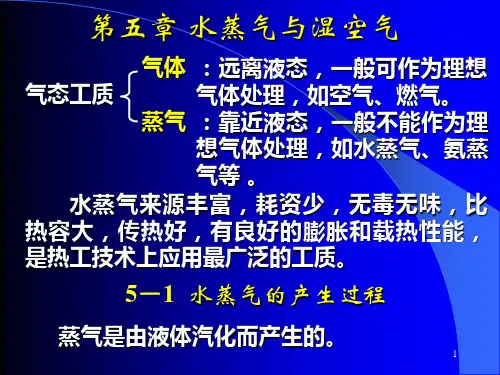

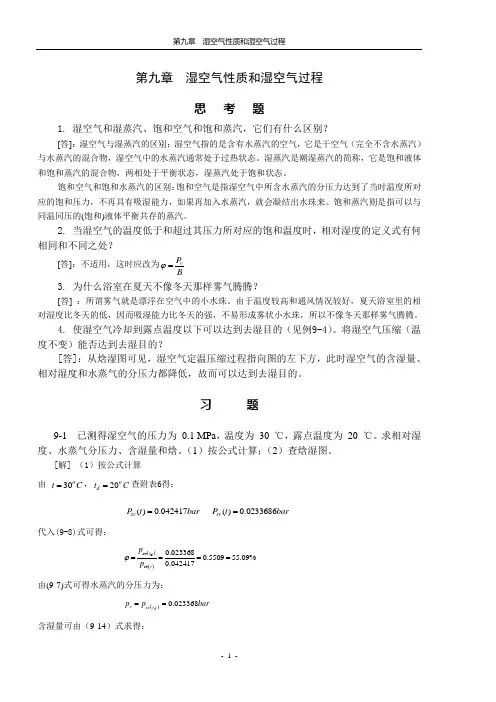
第九章 湿空气性质和湿空气过程思 考 题1. 湿空气和湿蒸汽、饱和空气和饱和蒸汽,它们有什么区别?[答]:湿空气与湿蒸汽的区别:湿空气指的是含有水蒸汽的空气,它是干空气(完全不含水蒸汽)与水蒸汽的混合物,湿空气中的水蒸汽通常处于过热状态。
湿蒸汽是潮湿蒸汽的简称,它是饱和液体和饱和蒸汽的混合物,两相处于平衡状态,湿蒸汽处于饱和状态。
饱和空气和饱和水蒸汽的区别:饱和空气是指湿空气中所含水蒸汽的分压力达到了当时温度所对应的饱和压力,不再具有吸湿能力,如果再加入水蒸汽,就会凝结出水珠来。
饱和蒸汽则是指可以与同温同压的(饱和)液体平衡共存的蒸汽。
2. 当湿空气的温度低于和超过其压力所对应的饱和温度时,相对湿度的定义式有何相同和不同之处?[答]:不适用,这时应改为v P Bϕ= 3. 为什么浴室在夏天不像冬天那样雾气腾腾?[答] :所谓雾气就是漂浮在空气中的小水珠。
由于温度较高和通风情况较好,夏天浴室里的相对湿度比冬天的低,因而吸湿能力比冬天的强,不易形成雾状小水珠,所以不像冬天那样雾气腾腾。
4. 使湿空气冷却到露点温度以下可以达到去湿目的(见例9-4)。
将湿空气压缩(温度不变)能否达到去湿目的?[答]:从焓湿图可见,湿空气定温压缩过程指向图的左下方,此时湿空气的含湿量、相对湿度和水蒸气的分压力都降低,故而可以达到去湿目的。
习 题9-1 已测得湿空气的压力为 0.1 MPa ,温度为 30 ℃,露点温度为 20 ℃。
求相对湿度、水蒸气分压力、含湿量和焓。
(1)按公式计算;(2)查焓湿图。
[解] (1)按公式计算由 30o t C =,20o d t C =查附表6得:()0.042417sv P t bar = ()0.0233686sv P t bar =代入(9-8)式可得:()()d sv sv 0.0233680.550955.09%0.042417t t p p ϕ==== 由(9-7)式可得水蒸汽的分压力为:()0.023368d v sv t p p bar ==含湿量可由(9-14)式求得:()0.55090.04241762262214.88/(?)-()1-0.55090.042417sr sr P t d g kg DA B P t ϕϕ⨯==⨯=⨯ 水蒸汽的焓可由(9-16)式求得:1.0050.001(2501 1.859)1.005300.00114.88(2501 1.85930)68.19/()H t d t kJ kg DA =++=⨯+⨯⨯+⨯=•(2)查 H-d 图(附录图Ⅲ)可得:55%ϕ=,()0.0233dv sv t p p bar ==,15/()d g kg DA =•,68/()H kJ kg DA =• 可见(1)、(2)两种方法求得参数是很吻合的。
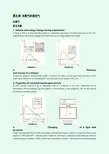
第五章 水蒸气和湿空气水蒸气 英文习题1. Volume and energy change during evaporationA mass of 200 g of saturated liquid water is completely vaporized at constant pressure of 100 kPa. Determine (a) the volume change and (b) the amount of energy added to the water.2.Pressureand volume of a mixtureA rigid tank contains 10 kg of water at 90℃. If 8 kg of the water is in the liquid form and rest is in thevapor form. Determine (a) the pressure in the tank and (b) the volume of the tank.3. Properties of saturated liquid-vapor mixtureAn 80-L vessel contains 4 kg of refrigerant-134a at a pressure of 160 kPa. Determine (a) the temperature of the refrigerant, (b) the quality, (c) the enthalpy of the refrigerant, and (d) the volume occupied by the vapor phase.4.Charging of a rigid tankby steamA rigid insulated tank that is initially evacuated is connected through a valve to a supply line that carries steam at 1 MPa and 300℃. Now the valve is opened, and steam is allowed to flow slowly into the tank until the pressure reaches 1 MPa, at which point the valve is closed.Determine the final temperatureFIGURE 5-1FIGURE 5-2FIGURE 5-3FIGURE 5-4of the steam in the tank.湿空气 英文习题1. The amount of water vapor in room air100 kPa A 5-m ×5-m×3-m room shown in Fig.5-1 contains air at 25℃ and at a relative humidity of 75 percent. Determine (a) the partial pressure of dry air, (b) the specific humidity, (c) the enthalpy per unit mass of the dry air,and (d) the masses of the dry air and water vapor in the room.2. Fogging of the windows in a houseIn cold weather, condensation frequently occurs on the inner surfaces of the windows due to the lower air temperatures near the window surface. Consider a house, shown in Fig.5-6, that contains air at 20℃ and 75 percent relative humidity. At what window temperature will themoisture in the air start condensing on the inner surfaces of thewindows?3. The specific and relative humidity of airThe dry and the wet-bulb temperatures of atmospheric air at 1 atm (101.325 kPa) pressure are measured with a sing psychrometer and determined to be 25℃ and 15℃, respectively. Determine (a0 the specific humidity, (b0 the relative humidity, and © the enthalpy of the air.4. Heating and humidification of airAn air-conditioning system is to take in outdoor air at 10℃ and 30 percent relative humidity at a steady rate of 45 m 3/min and to condition it to 25℃ and 60 percent relative humidity. The outdoor air is first then heated to 22℃ in the heating section and humidified by the injection of hot steam in the humidifying section. Assuming the entire process takes place at a pressure of 100 kPa, determine (a) the rate of heat supply in the heating section and (b) the mass flow rate of the steamrequired in the humidifying section.5. Cooling and dehumidification of airAir enters a window air conditioner at 1 atm, 30℃, and 80 percent relative humidity at rate of 10 m 2/min, and it leaves as saturated air at 14℃. Part of the moisture in the air that condenses during the process is also removed at 14℃. Determine the rates of heat and moisture removal from the air.工程热力学与传热学第五章 水蒸气与湿空气 习题FIGURE 5-5FIGURE 5-6FIGURE 5-7习题1.热水泵必须安装在热水容器下面距容器有一定高度的地方,而不能安装在热水容器的上面,为什么?2.锅炉产生的水蒸气在定温过程中是否满足q=w的关系?为什么?3.有无0℃或低于0℃的蒸汽存在?有无高于400℃的水存在,为什么?4.25MPa的水,是否也象1MPa的水那样经历汽化过程?为什么?5.dh=c p dT适用于任何工质的定压过程,水蒸气定压汽化过程中dT=0,由此得出结论,水定压汽化时dh=c p dT=0,此结论是否正确,为什么?6.试解释湿空气,湿蒸汽,饱和湿空气。
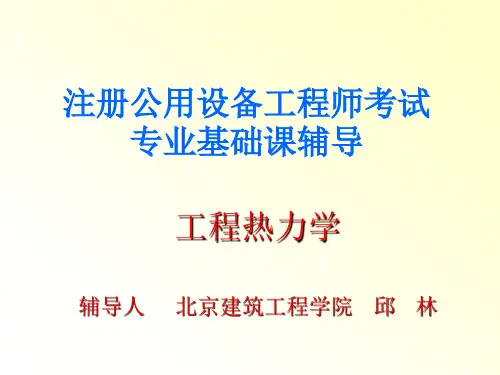
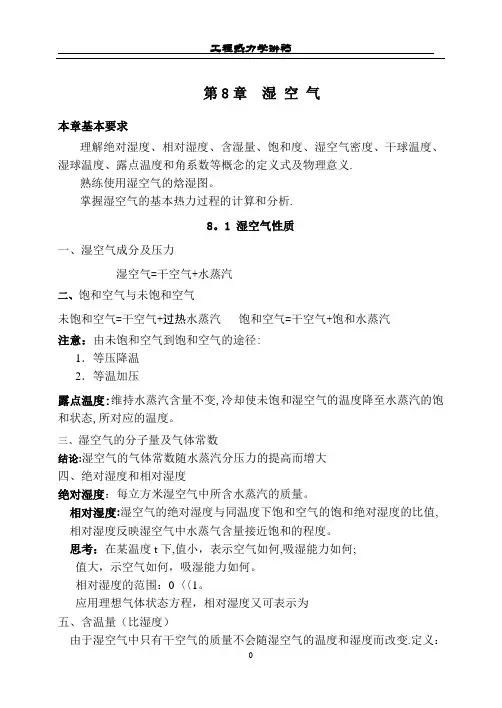
第8章湿空气本章基本要求理解绝对湿度、相对湿度、含湿量、饱和度、湿空气密度、干球温度、湿球温度、露点温度和角系数等概念的定义式及物理意义.熟练使用湿空气的焓湿图。
掌握湿空气的基本热力过程的计算和分析.8。
1 湿空气性质一、湿空气成分及压力湿空气=干空气+水蒸汽二、饱和空气与未饱和空气未饱和空气=干空气+过热水蒸汽饱和空气=干空气+饱和水蒸汽注意:由未饱和空气到饱和空气的途径:1.等压降温2.等温加压露点温度:维持水蒸汽含量不变,冷却使未饱和湿空气的温度降至水蒸汽的饱和状态,所对应的温度。
三、湿空气的分子量及气体常数结论:湿空气的气体常数随水蒸汽分压力的提高而增大四、绝对湿度和相对湿度绝对湿度:每立方米湿空气中所含水蒸汽的质量。
相对湿度:湿空气的绝对湿度与同温度下饱和空气的饱和绝对湿度的比值,相对湿度反映湿空气中水蒸气含量接近饱和的程度。
思考:在某温度t下,值小,表示空气如何,吸湿能力如何;值大,示空气如何,吸湿能力如何。
相对湿度的范围:0〈〈1。
应用理想气体状态方程,相对湿度又可表示为五、含温量(比湿度)由于湿空气中只有干空气的质量不会随湿空气的温度和湿度而改变.定义:含湿量(或称比湿度):在含有1kg干空气的湿空气中,所混有的水蒸气质量称为湿空气的).g/kg(a)六、焓定义:1kg干空气的焓和0。
001dkg水蒸汽的焓的总和代入:g/kg(a)七、湿球温度用湿纱布包裹温度计的水银头部,由于空气是未饱和空气,湿球纱布上的水分将蒸发,水分蒸发所需的热量来自两部分:1.降低湿布上水分本身的温度而放出热量.2.由于空气温度t高于湿纱布表面温度,通过对流换热空气将热量传给湿球。
当达到热湿平衡时,湿纱布上水分蒸发的热量全部来自空气的对流换热,纱布上水分温度不再降低,此时湿球温度计的读数就是湿球温度.湿球加湿过程中的热平衡关系式:由于湿纱布上水分蒸发的数量只有几克,而湿球温度计的读数又较低,在一般的通风空调工程中可以忽略不计。
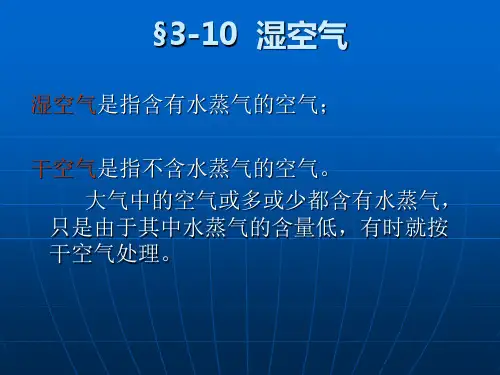
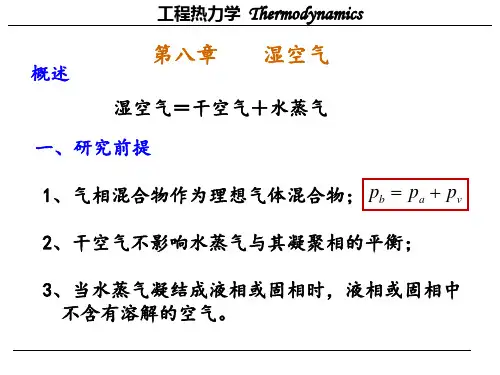
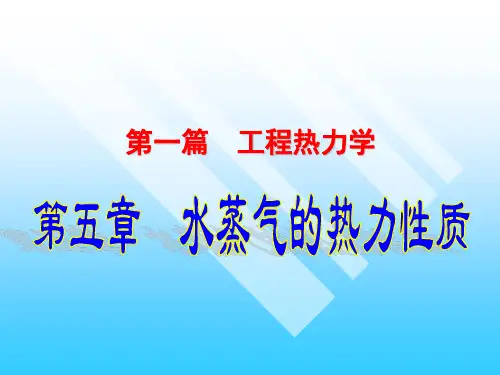
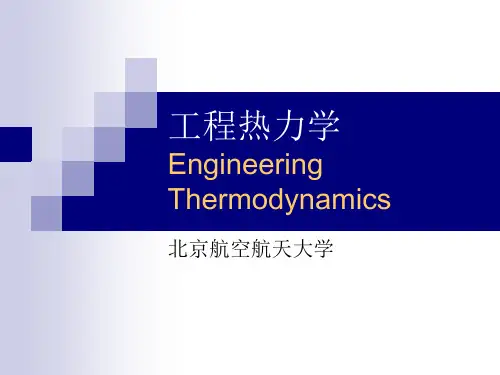
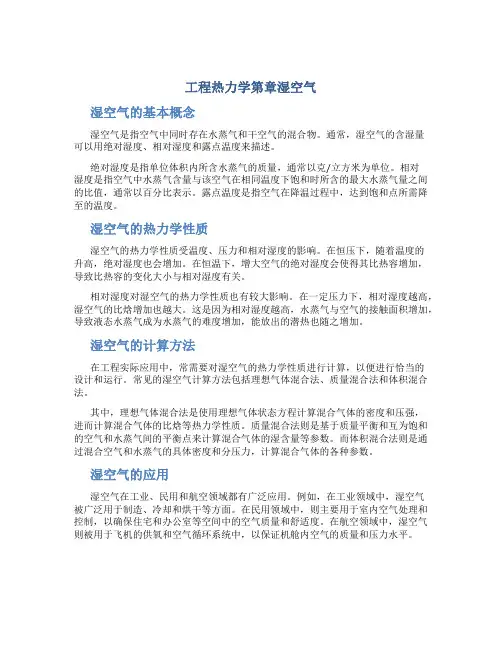
工程热力学第章湿空气湿空气的基本概念湿空气是指空气中同时存在水蒸气和干空气的混合物。
通常,湿空气的含湿量可以用绝对湿度、相对湿度和露点温度来描述。
绝对湿度是指单位体积内所含水蒸气的质量,通常以克/立方米为单位。
相对湿度是指空气中水蒸气含量与该空气在相同温度下饱和时所含的最大水蒸气量之间的比值,通常以百分比表示。
露点温度是指空气在降温过程中,达到饱和点所需降至的温度。
湿空气的热力学性质湿空气的热力学性质受温度、压力和相对湿度的影响。
在恒压下,随着温度的升高,绝对湿度也会增加。
在恒温下,增大空气的绝对湿度会使得其比热容增加,导致比热容的变化大小与相对湿度有关。
相对湿度对湿空气的热力学性质也有较大影响。
在一定压力下,相对湿度越高,湿空气的比焓增加也越大。
这是因为相对湿度越高,水蒸气与空气的接触面积增加,导致液态水蒸气成为水蒸气的难度增加,能放出的潜热也随之增加。
湿空气的计算方法在工程实际应用中,常需要对湿空气的热力学性质进行计算,以便进行恰当的设计和运行。
常见的湿空气计算方法包括理想气体混合法、质量混合法和体积混合法。
其中,理想气体混合法是使用理想气体状态方程计算混合气体的密度和压强,进而计算混合气体的比焓等热力学性质。
质量混合法则是基于质量平衡和互为饱和的空气和水蒸气间的平衡点来计算混合气体的湿含量等参数。
而体积混合法则是通过混合空气和水蒸气的具体密度和分压力,计算混合气体的各种参数。
湿空气的应用湿空气在工业、民用和航空领域都有广泛应用。
例如,在工业领域中,湿空气被广泛用于制造、冷却和烘干等方面。
在民用领域中,则主要用于室内空气处理和控制,以确保住宅和办公室等空间中的空气质量和舒适度。
在航空领域中,湿空气则被用于飞机的供氧和空气循环系统中,以保证机舱内空气的质量和压力水平。
湿空气作为空气和水蒸气混合产物,其热力学性质和应用领域较为广泛。
了解湿空气的基本概念、热力学性质和计算方法等,对于理解其在工程实际应用中的作用和价值具有重要意义。
7-1当水的温度t=80℃,压力分别为0.01、0.05、0.1、0.5及1MPa 时,各处于什么状态并求出该状态下的焓值。
解:查表知道t=80℃时饱和压力为0.047359MPa 。
因此在0.01、0.05、0.1、0.5及1MPa 时状态分别为过热、未饱和、未饱和,未饱和、未饱和。
焓值分别为2649.3kJ/kg ,334.9kJ/kg ,335kJ/kg ,335.3kJ/kg ,335.7kJ/kg 。
7-2已知湿蒸汽的压力p=1MPa 干度x=0.9。
试分别用水蒸气表和h-s 图求出h x ,v x ,u x ,s x 。
解:查表得:h``=2777kJ/kg h`=762.6kJ/kgv``=0.1943m 3/kg v`=0.0011274m 3/kgu``=h``-pv``=2582.7kJ/kg u`=h`-pv`=761.47kJ/kgs``=6.5847kJ/(kg.K)s`=2.1382kJ/(kg.K)h x =xh``+(1-x)h`=2575.6kJ/kgv x =xv``+(1-x)v`=0.1749m 3/kgu x =xu``+(1-x)u`=2400kJ/kgs x =xs``+(1-x)s`=6.14kJ/(kg.K)7-3在V =60L 的容器中装有湿饱和蒸汽,经测定其温度t =210℃,干饱和蒸汽的含量m v =0.57kg ,试求此湿蒸汽的干度、比容及焓值。
解:t =210℃的饱和汽和饱和水的比容分别为:v``=0.10422m 3/kg v`=0.0011726m 3/kgh``=2796.4kJ/kg h`=897.8kJ/kg 湿饱和蒸汽的质量:xm m v =`)1(``v x xv mV −+=解之得:x=0.53比容:v x =xv``+(1-x)v`=0.0558m 3/kg焓:h x =xh``+(1-x)h`=1904kJ/kg7-4将2kg 水盛于容积为0.2m 3的抽空了的密闭刚性容器中,然后加热至200℃试求容器中(1)压力;(2)焓;(3)蒸汽的质量和体积。